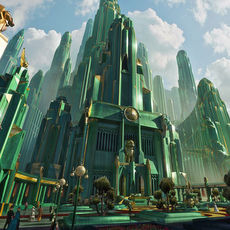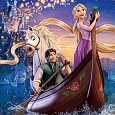 When continually asked for more Three Little Pigs cartoons after the immense success of his 1933 cartoon short, Walt Disney famously quipped “You can’t top pigs with pigs!” It was, until recently, a philosophy that the Studio upheld, breaking the rule but twice, for theatrical follow-ups to The Rescuers and Fantasia, but when Aladdin and The Lion King proved such smashes, the powers that be couldn’t resist providing audiences with more pigs: a series of direct to video titles that admittedly could surprise once in a while, but more often than not earned their nickname of “cheapquels” for all too obvious reasons.
When continually asked for more Three Little Pigs cartoons after the immense success of his 1933 cartoon short, Walt Disney famously quipped “You can’t top pigs with pigs!” It was, until recently, a philosophy that the Studio upheld, breaking the rule but twice, for theatrical follow-ups to The Rescuers and Fantasia, but when Aladdin and The Lion King proved such smashes, the powers that be couldn’t resist providing audiences with more pigs: a series of direct to video titles that admittedly could surprise once in a while, but more often than not earned their nickname of “cheapquels” for all too obvious reasons.
When Disney brought Pixar – and new head John Lasseter – into the fold, one of his first decrees was that this profitable but creatively bankrupt practice be brought to an end: no more sequels (or prequels, or midquels). No more Cinderella II or Little Mermaid II (hopefully), no more Cinderella III or Bambi II (unfortunately). With the recent release of The Little Mermaid: Ariel’s Beginning, the end of an era has been sounded and marked by the departure of the not always popular Sharon Morrill from the presidency of DisneyToon Studios, the division that sprang from Walt Disney Television Animation to produce these films. As every ending is an occasion to look back and see what was done…and what was not done…we approached Tod Carter, a long-time DisneyToon collaborator, to be our guide through the history of the unit.
A big name in the animation industry, the award-winning Director of Animation and Story Artist began his 15-year career in film and animation as a graduate of the Fine Arts Program at the University of Illinois at Chicago. Tod has utilized his skills and talents to create and establish Chicago-based animation studios for Terra Glyph Interactive, Media Station Inc. (producers of Disney Interactive CD ROMs) and Character Builders (animation providers for many of the direct to video features). Tod has been equally prolific in his commercial work for major motion picture studios, well known within this circle, and his list of credits continues to grow.
His work for Warner Bros. includes animation for Quest For Camelot and Space Jam as well as numerous commercials featuring the Looney Tunes characters. His animation credits include work for DreamWorks Home Video on Joseph, King of Dreams and Pocahontas II for Disney. Tod also contributed story development to DisneyToons for video sequels to The Hunchback of Notre Dame, Tarzan, The Fox and the Hound and the never to be realized sequels Aristocats 2 and Chicken Little 2. Also well-know for his key participation in the Veggie Tales series, he is currently working as an animation and story consultant for film and commercial projects.
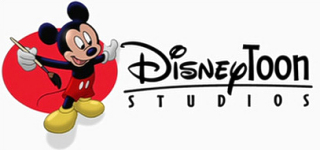
Animated Views: You were trained in animation and live action. How did that happen?
Tod Carter: I grew up in Chicago, a child of the 70s, watching cartoons on TV. I guess you could say that’s my true background. I always had a love for drawing, even at a very young age. Of course I wanted to grow up to be an “artist”, but I didn’t really know what that meant. How does one really make a living as an artist? We all have heard the cliché of being a “starving artist”. By the time I reached college, my dream of being an artist hadn’t died but I was pretty sure that I didn’t want to be starving, so I was frantically trying to figure out a suitable resolution to that problem.
 Really, what I enjoyed doing was making pretty pictures but I couldn’t figure out why someone would actually pay me to do that. This was in the mid 80s which was a unique and exciting time. Computers had been around for a little while but the programs that allowed artists to use the technology creatively were really just taking hold. I believe DeluxePaint for the Amiga was one of the few tools available at the time. It’s pretty archaic stuff by our current standards, but it was exciting to a young artist at the time. The new technology had the look of “The Future” and I was drawn into it as were many my age. I decided to pursue my education locally and enrolled at the University Of Illinois at Chicago. Because the Computer Graphics program was so small, and limited to only a few classes, it was lumped into the greater curriculum of the Film Program. So, it happened quite by accident, that I found myself involved as a film student.
Really, what I enjoyed doing was making pretty pictures but I couldn’t figure out why someone would actually pay me to do that. This was in the mid 80s which was a unique and exciting time. Computers had been around for a little while but the programs that allowed artists to use the technology creatively were really just taking hold. I believe DeluxePaint for the Amiga was one of the few tools available at the time. It’s pretty archaic stuff by our current standards, but it was exciting to a young artist at the time. The new technology had the look of “The Future” and I was drawn into it as were many my age. I decided to pursue my education locally and enrolled at the University Of Illinois at Chicago. Because the Computer Graphics program was so small, and limited to only a few classes, it was lumped into the greater curriculum of the Film Program. So, it happened quite by accident, that I found myself involved as a film student.
I was one of the few in the department that could draw well, so I distinguished myself a bit in the animation classes that were available (although, I must admit that I did have one instructor tell me that there was no future for me as an animator because I could not draw well enough). After a few years of school, I had decided that I would pursue a career in film as a Director of Photography in live action. I was convinced that my new love of film would steer my life in that direction. But, after a minor stint in a live action film as a 3rd AD, I became a bit disillusioned with the process. I was working, but just not creatively and I wanted to change that before it was too late. I put together my student reel and (with great persistence) landed my first animation job as a cell painter on Captain Crunch commercials. So, it was in this roundabout way that I would begin my career in the animation industry. Every artist draws upon all their experiences and pours them into their work. My experiences are a bit varied but each one contributes to my vision as an artist.
People often ask me about what I study as a filmmaker to learn and improve. I think most animation students assume that I would focus mainly on animation but the truth is that I really like to study live action films. The reason is twofold. I think real people/characters offer a rich source of inspiration for animated characters and there is a rich tradition in animation that establishes this idea. The other reason is that since I’ve been working on a lot of CG animated film projects, there is a great flexibility that can be accomplished that virtually mimics live action camera technique in the CG realm. I love animated films, don’t get me wrong but you can easily see how animated films in the last decade have really moved closer to their live action counterparts in style and sensibility with great results. A film worthy of study that comes to mind is Hot Fuzz by director Edgar Wright (also of Shaun of the Dead). This director’s camera and editing style are both quite stylized and very deliberate and is a source of great inspiration that I recently enjoyed.
AV: Your experience combines Animation and Story Development, doesn’t it?
TC: Since I started in animation in the late 80s, I’ve had the opportunity to work my way up from cell painting, inking, inbetweening, animating, story artist, story supervisor and finally to director and sometimes writer. I’ve always worked outside the larger studios, which has provided me the opportunity to do it all. My first true passion was at the board as an animator. In the mid 90s there was an incredible boom in the industry which provided great opportunities for artists. At the time, I was given an opportunity to work for Character Builders, based out of Columbus, Ohio. Character Builders was rolling along pretty well and contributing feature animation to a number of projects. During this growth phase they were looking for some good talent. After contracting me and another local artist to do animation for Space Jam, they decided to bring us on staff. Because moving to Ohio wasn’t a great option at the time, they gave us the chance to open a satellite studio in Chicago that began as a two-person studio but quickly grew to about a dozen artists. Unfortunately, this business can be quite cyclical and as the industry contracted, things really changed. Our entire production team was laid off as the trend to outsource animation overseas kicked in.
Because Character Builders had shown great competency in delivering work to the Disney direct to video department (now DisneyToons) they were offered a chance to produce the sequel for The Hunchback of Notre Dame, along with director Steve “Oscar” Moore. It was at this same time, while I was essentially packing my things and heading out the door, that director/producer Jim Kammerud called me. I guess he must have liked something I was doing because he asked me if I thought I could storyboard. Well, I can tell you it never really crossed my mind but I realized long ago that if someone asks you if you can do something, you just say “yes” and figure it out later. So, it was on Hunchback that I received my on-the-job training as a story artist. It was never by design or part of a grand plan, but I feel it was really the beginning of my true profession, as I was laying the foundation for becoming a filmmaker.

AV: As an animator, you worked for different studios like DreamWorks, Warners and Disney. Did you see differences in their approaches to animation?
TC: I did quite a bit of work for Warner Bros. on Animaniacs which really shaped my early style. I think most animators will think of Chuck Jones and Warner Bros. as being synonymous. So, in truth, it was the artistic style of Chuck Jones that I tried to imitate. He, of course, is a true master of timing and comedy. Working for Disney is quite different since the sensibilities are very different. Disney focuses on more subtle techniques and the beauty of realism. Both techniques require the study of life, but whereas the Warners style is generally much broader, the Disney style is usually closer to realism. I think this is true in their approaches to story as well as animation. Of course, you can find good exceptions in each case.
 AV: How was your experience on Pocahontas II like?
AV: How was your experience on Pocahontas II like?
TC: Pocahontas II was produced at an incredibly fast pace. If fact, most projects are, and I think many people would be surprised how we fly by the seat of our pants as we create projects. For this project we had a fairly short time to ramp up and learn the characters. Probably about a week, if I remember correctly. To make matters worse, it was 1998 and the video release for the original film wouldn’t come out till about 2000. Therefore, even though we were supplied with a fair amount of production drawings and model sheets, we didn’t have access to the original animated film itself. This may surprise a lot of people, but the majority of sequels I’ve worked on were all handled this way. During this time, we worked feverishly to try and hone the style.
Of course, you must realize that few artists can draw the way John Pomeroy (Supervising Animator for John Smith) can. This put us in quite a spot because we needed to mimic his animation as well as that of many other talented feature artists. Now, I will tell you, that if you took a room of animators and gave them a choice between animating Pocahontas and Meeko the raccoon, nine out of ten artists will choose Meeko. The reason being is that it’s much more fun to do the broad character comedy of a character like Meeko. Also, it’s incredibly challenging to draw lifelike characters like Pocahontas and John Smith and the subtle realism that is required to make their acting believable. The stylistic realism of these human characters can really display the flaws of an artist.
Unfortunately for me, I could pull off the human characters just well enough to land those main characters for Pocahontas II. While I toiled away with human characters doing all sorts of difficult acting and action, I watched others enjoy working on lively scenes involving Meeko, Flit and Percy. I was also assigned to animate quite a few scenes involving characters riding horses. It was a challenging show, to say the least. By the end, I really wanted to let loose and draw some funny cartoons.

AV: What appealed to you about the very specific art of storyboarding?
TC: Going from animating to storyboarding is a significant change. The beauty of storyboard for me is the ability to see and affect things globally. You really get to see the big picture and develop the film at a higher level. Animating can be a very solitary endeavor in some ways. Working in story is very much a communal effort in its function. Whereas animating focuses on performance, boarding focuses on storytelling. I always felt that animating was much more of a precise drawing skill while boarding required a broader set of drawing skills and allowed for looser representations.
AV: When I see your storyboard drawings, I don’t just see rough story drawings, but beautiful drawings, with shadows, textures, etc. There is also much technical information and most of all, emotion (like in the Tarzan/Zugor dialogue for Tarzan II). How do you create your storyboards?
TC: First of all, thanks for the compliment! This is really a great question because the answer outlines what is really necessary to elevate the art form. I’m always trying to learn and improve and, in doing so, I hope that my story work is always evolving. You can see some variety in my samples due to that approach. The first show I ever boarded was for Hunchback II. What I did was probably what most young board artists do when they first start. I spent a lot of time trying to make great drawings and really flesh out the characters and backgrounds in detail in order to make a good impression with the director. This is really the wrong approach and I soon learned my mistake when I saw the first cut of the animation reel.
My drawings, with their rendered backgrounds and heavy shading that seemed so accomplished when I first did them, were barely legible when cut into a reel and displayed in sequence. It’s important to remember that each story panel will be visible for only a fraction of a second and therefore must be stripped down to its bare and essential elements, while still projecting just the exact emotion and acting (not to mention camera information). In other words, they must be CLEAR. Clear of all unnecessary information and full of everything relevant that can be viewed and absorbed in an instant. Of course, this is a skill that isn’t learned overnight and may never be truly mastered, it must be continually developed.

I’ll give you a little bit of insight into the process. Obviously, we start with a script and a scene hand off with the director. The director gives his insight on how he feels the scene plays out. I’ve worked with directors who have given very detailed information and even thumbnail drawings and I’ve worked with directors who have handed me a script and said, “Make it funny”. I personally like to get very little direction because it allows me to work harder and become vested in the ideas. By this I mean, that as I develop ideas I have the freedom to let my inspiration dictate where the scene is heading and how it plays out. It’s just more fun for me to work that way.
Next, I usually do some thumbnail drawings to choose my shots and help create a sense of continuity. The thumbnails, in most cases, are barely legible to anyone but me. I spend very little time on the drawings themselves. The real effort is in trying to get great ideas. I’m concerning myself with camera direction, blocking, pacing and having good business for the actors. Also, if there are elements of the scene that just aren’t working well, I’m trying to address solutions at this point. I will play the whole sequence out in my head while looking at the thumbnail scribbles I’ve drawn. By now I’m pretty good at envisioning what the scene will look like and how it will play, even before making the boards.
Now that I’ve done all my scene planning, I get down to making the real thing. I’ve tried lots of different techniques for doing the boards themselves. I’ve done pencil, Col-erase pencil, Prisma-color, grease pencil, ink pens and most currently Cintiq tablet. Sometimes, I would do a rough and clean up over my original, sometimes I would just do one drawing and not clean at all. Most of the Tarzan drawings were done with Prismacolor and probably had some light under-drawing with a pencil. I have found that the key to creating good and expressive boards is to draw quickly and with emotion. It goes without saying that the key to being able to loosen up your drawing style, is to lay down a good foundation with years of practice drawing from life.
When I draw a character I really try to FEEL the emotion as I draw. (Sometimes my wife laughs at me because I make what she calls “a drawing face” which is really just me imitating the character I’m making). If you draw slowly and too deliberately you will have a harder time getting great emotion in your drawings. I usually do my under drawings very quickly and without great regard for model. I can then go back and tighten the drawing and put it more on-model while hopefully retaining most of the expressions. I’m convinced that my best work is produced when I’m working very, very quickly. This keeps my brain from getting in the way of the creative process.
AV: How do you choose the tools you use for drawing?
TC: I’ve been using the Cintiq for about a year now. It does take some adjustment and it’s only as good as the drawing software that you’re using. Photoshop, for instance isn’t a very good tool for drawing (although I understand that artists at Pixar use it for boarding, which really surprises me). Corel Painter has much better drawing tools but the interface is a bit cumbersome, in my opinion. I’ve tried a version of Toon Boom Storyboard Pro, but I wasn’t too crazy about the drawing tools in the version I tried (but I thought the program had a lot to offer in its ability to organize a project). My software of choice for boarding via Cintiq is Autodesk Sketchbook Pro (formerly Alias Sketchbook Pro).
Despite some peccadilloes, this software has an incredibly efficient interface and some excellent drawing tools that can emulate pencil and pen, as well as others. It also works in layers to allow for easy reuse of backgrounds and other elements. Even though it does have some shortcomings, I’m disappointed to hear that Autodesk isn’t pursuing support or development of this software, so future upgrade versions are not likely. Hopefully, someone will pick up where Autodesk leaves off. Storyboarding via Cintiq offers some advantages in efficiency and obviously saves a lot of time since you don’t have to scan. I do lose a bit in line control and the ability to fine tune a drawing, but overall it’s a good solution for a fast-paced production.
AV: You worked on some Disney video sequels that never were. Can you tell me about them, starting with Aristocats 2?
TC: Well, the story of these films is a little convoluted and I’ll do my best to keep the facts straight. I was asked by director Jim Kammerud of Hot Donut (formerly of Character Builders) to help with boarding on Artistocats 2. This film went through multiple scripts and different incarnations and probably didn’t really have a clear vision in the beginning. Our goal was to create that vision and tell a solid story. With the exception of retaining the main characters, we were given a good deal of freedom to create original story (similar to Fox and the Hound 2). We were given a script to work with, but unfortunately a good deal of time and money had already been spent on the previous versions (before we got the job) and the producers at Disney were getting a little antsy to get the film rolling and put something onscreen.
We felt the script still needed some work, but the schedule wasn’t going to afford us the opportunity to rework the current version and still deliver the film on time and on budget. So, a unique plan was hatched by Jim Kammerud to deliver the first rough story reel quickly and thus allow us some time at the end of the schedule to rewrite and fine tune the story a good deal. The proposed time frame was four weeks. When I heard this suggestion I said, “Ok, great. Four weeks is tight, but I think we can get the first act done.” Jim said, “No, four weeks to do all three acts.” I honestly didn’t think it could be done. I wish I could remember how many board artists we had, but it wasn’t that many; possibly five or six. This was a Herculean task and I can tell you that I don’t think it had ever been done for a film of that scale.
It would take a unique approach, so we devised a method where we (I’m not sure if everyone drew the same) would essentially do large thumbnail board drawings instead of full size boards. We created board panels on 7.5” X 4.5” paper with 4.5” x 2.5” inset frames. Our drawings would fit inside the smaller window area and the dialog and camera direction would be written below. The paper was at a size that was easy to handle and stack while still allowing us to draw at a small scale. Obviously, with such a small window to draw in, we couldn’t do detailed or elaborate drawings. We’d have to limit the drawings to clear and essential information. At the time, I was convinced the results would be less than acceptable but I was surprised when I viewed our first story reel. The weaknesses in our story were apparent but the overall quality of the reel was really quite good. In the end, I think we pulled it off in five weeks, which was remarkable.
To make a long story short, Artistocats 2 was eventually shelved because there was skepticism by the executives that it would find sufficient audience in an ever more competitive market. It’s one of those disappointing things that happen in the film business from time to time, but it may have been a wise call. The good news was that we had pulled off our little experiment and succeeded in delivering a quality reel in record time. The bad news was that we had established a precedent of what can be accomplished in that time frame and the producers and budgeters at Disney had taken notice.
AV: What was that story like?
TC: To make Artistocats 2, we tried to distill the essence of the original film. In the first film, the kittens’ nemesis was a misguided butler intent on stealing their fortune. The sequel created a similar dynamic by pitting them against a jewel thief on the open seas aboard a luxury cruise ship.
The flavor of the film was sort of a mystery/farce/comedy. There was also a young kitty love interest for Marie who became the focal character of the film. By singling out one character for the central story arc we could do a better job at strengthening the elements of the film. Sometimes when you have an ensemble cast, things can really get watered down because you don’t have enough time to spend with each character. We tried to avoid that pitfall.
The original film takes place in Paris but we didn’t feel they exploited the setting to its fullest potential. We wanted to adopt a European flair by filling our ship with a cast from places like France, Scotland, England, Spain, etc, thus creating a rich environment in both scenery and character in the era of the early 1900s. Our main objective besides the mystery element was to make it completely fun. We worked hard to up the action scenes and create a level of high energy.
I really think this film was headed in the right direction and with another pass we could have gotten it right but there are other important considerations in making films of any kind. Making sure you have an audience for your movie is paramount. Disney just felt that Aristocats 2 was in jeopardy of falling through the cracks in a competitive marketplace.
Another interesting side note by the way – originally this movie was slated to be a traditionally 2D animated film like the original, but that strategy was eventually changed by Disney Execs who felt that a CG animated version might do a better job at capturing interest. I personally am not a big fan of converting characters from 2D to CG mainly because there is an importance in designing for your targeted medium. Going this route, we probably would have lost a good deal of softness which is essential to these character’s charm but since it was ultimately shelved the world will never know for sure.
AV: With all these characters from different countries and one thief among them, there seems to be an “Hercule Poirot” flavor to it.
TC: Yes, exactly. Sort of a Murder On The Orient Express without the murder.
AV: Afterwards, there was Chicken Little 2?
TC: Not long after that project was shelved, I received a call from Klay Hall, who was directing Chicken Little 2. He was given the mandate to create a story reel for his project in the same time frame that we did for Aristocats 2. I don’t think he or the other board artists at Disney were too excited about the deadline, but I guess Klay figured that it would be a good idea to get someone involved who had actually had experience working at this pace. Overall, the script for Chicken Little 2 was pretty good and I felt great about the sequences in which I was involved. Klay gave me a good deal of freedom to invent and I really appreciated working with him and loved the project.
In the story, Chicken Little finds himself in the midst of a love triangle. On one side, is his childhood sweetheart (but not too attractive) Abby “ugly-duck” Mallard. On the other side, is the very attractive newcomer, Raffaela, the French sheep. Abby’s at a tremendous disadvantage here, so she goes to great lengths to give herself a makeover. A portion of the makeover sequence is represented on my website, which shows Abby’s grand entrance at school with her new-found look. The script, in this case, had dialog but very little specific action, so most of the visuals and business are original ideas that I was free to invent. Working on this type of scene is great fun for an artist.
By the time the first reel was being finished, the crew was fairly excited about the direction the show was heading. The story I heard, was that the screenings were going extremely well and at one point there was talk that Disney would actually increase the budget since they felt they wanted to up the production quality to match the quality of the story. Sadly, in their next breath, Disney pulled the plug on the project. It was a reactionary move (in my opinion) to sales figures for current projects and the overall market. The executives didn’t feel that the original film had a wide enough market to draw upon to support the sequel. We’ll never know for sure, but I really feel the film was progressing well and would have succeeded.
AV: You also did a “White Whale Chase” sequence involving Little Mermaid characters. What was that?
TC: This sequence was actually mocked up for a storyboarding test I did for Disney TV, when I was toying with the idea of moving to L.A. I never submitted it, but since it was one of the few examples of TV boards I’ve done, I decided to include it in my gallery for a bit of variety. Doing TV boards is quite a bit different than film or direct to DVD productions. The main differences to me are in the fact that you must include very specific camera directions and your characters must be tightly on model. Also, it’s essential that your layouts are clear and well drawn since they are usually blown up and used for character layouts in production.
AV: Story development is a team process, but can it be a solitary work, alone with the script and your storyboard paper?
TC: Well, it’s a little bit of both. There can be a great deal of collaboration with the writer, director and other story artists, but a good deal of time must be spent at the board creating the visuals. Personally, I work best alone in a quiet room but I know some board artists who like to sit around a table and sketch out ideas and bounce them back and forth with other artists. It’s really just a matter of personal preference.
AV: Do you go back to the original movies to get into that universe for the sequels, or do you prefer to ignore them to find new directions?
TC: First, I’ll say a bit about creating sequels in general. I don’t think people realize the difficulty involved in pulling off a good sequel. The problem lies with the fact that you have already established a complete universe with characters and predetermined scenarios. The audience is full of expectations since they want to see all the characters and they want to see them doing all the same types of things they are well known for. In addition, the main character has already finished his/her character arc by the end of the first film and obviously you want to remain true to that character and not undo anything from the first film by rewriting history. Having said that, the next main obstacle is to keep it all fresh by introducing a new plot and all new characters and situations. Basically you end up with a script that is forced to accomplish too many things. For example, you could come up with a fantastic script for a Tarzan sequel, but if you didn’t include quality roles for Tantor and Terk you’d have to start all over again. There’s a tremendous responsibility involved and the artists involved really do want to pay due respect to the original.
Working on Fox and The Hound 2 was a little bit different than most of the other sequels I did. The original film doesn’t really have a strong following and wasn’t held up with the same regard as, say, Little Mermaid. Because of that, I was given more freedom to develop the story and for that reason I think it was probably one of the most successful sequels I have worked on. When we sat down and talked about what we really liked and wanted to retain from the original, it was quickly decided that the high cuteness factor of the young fox and hound and their relationship were the most redeeming elements of the film. Kids really responded well to those characters, much more so than to their grown-up versions. We decided to strip the story down to the bare elements of their childhood friendship and build it up from there. When I first got involved on the film, the country music theme had already been established. Besides the other two main human characters, there wasn’t much baggage that needed to carry into the film from the original, so it really distilled down to the question, “How can we make an entertaining film”. This was a tremendous freedom for the crew.
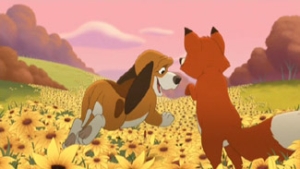
AV: For an artist who likes to work by himself, is it difficult to pitch your scenes in front of the crew?
TC: I have worked on productions where I was able to pitch the boards to the director and crew, but there have also been times when I had to send my artwork directly to the editor. The “pitch” is a pretty cool event since it’s sort of like performance art. Besides explaining the scene, you are playing the role of every character and your performance will influence how the director perceives the scene. You also have the ability to influence the timing of the eventual cut of the scene, since you will be pacing the boards as you do your pitch. The pitch process does create a certain amount of anxiety and not every board artist can perform well in this situation. I’ve had some great and some not so great experiences pitching sequences.
Overall, I have to say that I really enjoy the process since it’s your first opportunity to present your work and there’s no greater feeling than to pitch a joke that you wrote and receive enthusiastic laughs. Not every production affords the luxury of the pitch process. I’ve worked on productions where I simply handed over boards to the editing department, who then scanned them and cut together a rough edit for presentation. On occasion, I’ve done my own edit to make sure the director knew exactly what I was intending. Timing of the boards, particularly in comedy, has a tremendous importance and it’s essential that the editor knows your intent to insure the proper result. This is where a good pitch (or a good editor) can help.
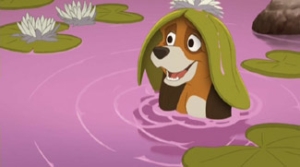
AV: You took part in Tinkerbell. Can you tell me about that experience?
TC: I don’t know the entire history of the Tinkerbell film and I’m more than a little surprised that it still hasn’t been released. I was asked by director Klay Hall to help with the boarding back in September 06. Since my daughter was four at the time, I was thrilled because she loved Tinkerbell and I was a hero in my own home. Tinkerbell is a huge Disney icon and certainly gave me tremendous satisfaction to be invited to participate. The version I was working on was the 2nd or 3rd script incarnation. Going back to my earlier comments about the difficulty of writing sequels, Tinkerbell is a perfect example.
In the original movie you have a character who doesn’t speak and whose environment is removed from modern technology and terminology. Now, how do you craft a script that makes Tinkerbell the main character, give her dialog, put her in a relevant context, create her in CG and still keep the charm factor from Walt’s vision? I know that Disney really wanted to get it right and had made a large investment for promotion and product development into what would be a big franchise for them. To complicate matters, there were already planned sequels as part of a trilogy of Tinkerbell films. The merger of Pixar and Disney occurred around the time I was finishing my involvement with the Tinkerbell project. From my understanding, Pixar had gotten involved and decided to revise the project quite a bit.
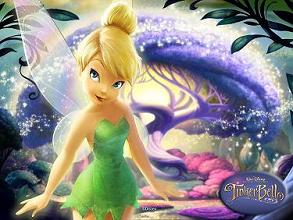
AV: How is it, continuing the lives and imagining new stories for classic heroes like the Aristocats or Tinkerbell? Is there a kind of a responsibility you feel?
TC: I always feel some responsibility toward characters, regardless of their origin. As an artist, you are required to give a voice to these characters and allow them to breathe. It’s important to me that when we expand the universe of the character we don’t adversely affect the history that has already by established. It can be a real trick to do that and maintain a fresh feel for the brand. That’s why a film like Toy Story 2 is so incredible, because it really stands out as a beacon in terms of what a sequel can accomplish.
AV: You founded another company recently, Brain Freeze. Can you tell us about that?
TC: I’ve always tried to look ahead and adapt to the changing climate in animation. It’s important to remember that although animation is an art form, it’s also a business. You need to have a variety of skills to survive the long-haul and stay productive. Also, learning and adapting is fundamental to an artist’s growth. Without the learning process, an artist will cease to be original and creative.
 2007 was one of my busiest years ever, since I was doing a variety of boarding jobs and also directing a TV series, 3,2,1 Penguins and a feature short Deja Grape. But in the midst of it all, I could see how the climate of entertainment was changing; fewer projects were being produced and budgets were being reduced. Meanwhile, everyone in entertainment was feverishly trying to figure out how to capitalize on the internet as a fresh revenue source for production. Unfortunately, since internet content is free, it is difficult to raise significant funds to create original content solely for internet viewing.
2007 was one of my busiest years ever, since I was doing a variety of boarding jobs and also directing a TV series, 3,2,1 Penguins and a feature short Deja Grape. But in the midst of it all, I could see how the climate of entertainment was changing; fewer projects were being produced and budgets were being reduced. Meanwhile, everyone in entertainment was feverishly trying to figure out how to capitalize on the internet as a fresh revenue source for production. Unfortunately, since internet content is free, it is difficult to raise significant funds to create original content solely for internet viewing.
What I could see was that advertising was the true growth market in this scenario, since there are new ad spaces being sold via internet and cable network. This creates a need for more advertising-related animation content. I started my career working on TV commercials, so in a way, I’m coming full circle. I created Brain Freeze Entertainment at the beginning of 08 as a source for high quality animation for TV, film, web, and just about any other media where animation can be seen. I still offer project directing, story development and design for any level of production, but Brain Freeze has given me the opportunity to expand my offering and take my career in a new direction.
I’ve also created a working relationship with Magnetic Dreams, an animation production company in Nashville, TN. Magnetic Dreams offers additional production support to Brain Freeze to allow for some scalability on BF projects and, in return, I offer support as director to select projects on their end. Our first collaboration was on Deja Grape and the results were fantastic. Although this is all very exciting for me, my true passion is creating original content and the long-term core business of Brain Freeze is to create original properties. We’ve got a few in the mix as well as a childrens’ book (Today I’m A Dinosaur, co-created with Dennis Bredow) that is near completion.
AV: Are you still storyboarding for the studios?
TC: I’ve done a lot of work recently for Big Idea on Veggie Tales projects and their recent film release, The Pirates Who Don’t Do Anything. Since Disney has merged with Pixar there has been some reworking on their end as they move forward and try to figure the best approach to develop DVD projects. John Lasseter is very much involved in Disney’s new development, which I think will be great for their future. I’ll have to see how it shakes out and hopefully I may have a role in future projects.

is available to buy now from Amazon.com
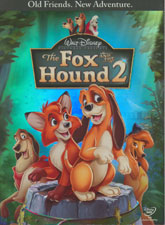
With all our gratitude to Tod for his kindness and great involvement in this article. For further information, feel free to visit his personal website and Brain Freeze online.





